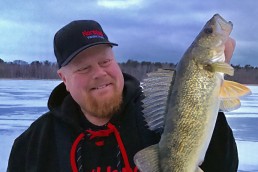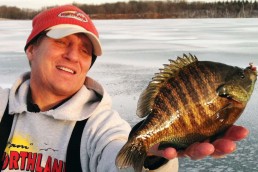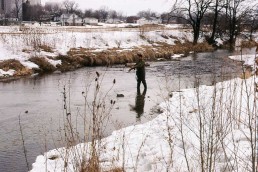Deadsticks Come Alive in Dead of Winter
SHARE THIS POST
Ice Fishing: Deadsticking
The concept of “deadsticking” goes way back in fishing. It describes any technique of putting out a bait and letting it sit there. It can be simple or complicated, depending on how you go about it. Anyone who has ever river-fished from shore probably used deadsticks without realizing it. Most anglers deadstick with a variation of a live-bait rig with a sinker, swivel, leader and a hook tipped with live bait. Anglers put their rods in a rod holder or a Y-stick and watch the rod tip or put a bell on the rod tip and wait to hear a jingle. Anglers often use a baitcasting reel with the clicker feature, so they can leave the reel disengaged without getting a backlash. The clicks tell them when a fish takes the bait.
Tip-ups are another popular type of deadsticking, with many variations and many different presentations. Anglers can use something like a live-bait rig setup with a sinker, swivel and leader with a hook or an ice jig. Anglers can dress them up a little with a small spinner, colored beads, colored hooks or any other combination anglers can dream up. Tip-up anglers can go extra plain when fishing in shallow water, with just a split shot, a hook and a minnow. Set larger, live minnows differently than a smaller minnow or a dead bait.
Tip-ups: Flagging fish
The trigger on the tip-up flag can be adjusted so it takes varying amounts of “pull” to set off the flag. Larger minnows need more tension. Smaller minnows or dead baits can be set on the lighter setting. Add a bell or a light to tip-up flags to help notice the bites more quickly. Many anglers use tip-ups as bonus lines when they fish out of rental houses or wheel houses to deploy the maximum number of lines that regulations allow.
Rattle reels used inside most fish houses are also types of deadsticks. The rattles inside the reels make noise when they turn, so anglers can hear the bites and don’t need to use a bobber. Many times, a rattle reel or kinds of deadsticks catch more fish than any type of jigging presentation.
Deadsticking to it
I have used different kinds of deadsticks in my winter guiding for many years. The Frabill Bro Series of rods includes several deadsticks with exactly the features I want. I want a bright-colored rod tip to more easily see the bites. The rod tip must be soft so it bends like a spring bobber. But, the rod also must have a good backbone. My hookset has to take up the slack in the line and still have enough power to drive home the hook.
Deadsticking for perch
I like to use a drop-shot rig on deadsticks. I put a bell sinker on the bottom of the drop-shot rig if I am fishing in sand or mud. I use a wire sinker for fishing in rocks. The hook of the drop-shot rig goes anywhere from 6 inches to 3 feet above the bottom, depending on where most of the perch are located. I like a longer-shank hook for drop-shotting, so I can get the bait farther from the main line.
Anglers usually need to use a little heavier line on a drop-shot rig (8- to 10-pound-test) because the extra knots can weaken the line. I would rather get a few less bites because of the heavier line than have to constantly repair the entire rig. Deadsticks with drop shots can be spread out like tip-ups, with anglers watching the rod tips for bites. I like to put the rigs on top of a bucket or in a rod holder to avoid losing any rods.
Are you enjoying this post?
You can be among the first to get the latest info on where to go, what to use and how to use it!
“Banding” together: Finding the right deadstick ice fishing rod
I designed a ‘Bro-Band’ for my deadstick rods. This goes on the spinning reel spool after the bait is down. Anglers can put the line under the band and leave the bail open. When a fish takes the bait, the line slips out from under the rubber band and free-spools off the reel. Anglers can also use the Bro-Band to hold rigs above the bottom at a certain depth. l use my Humminbird Ice 7 to set the depth or put a bobber stop at the water level, so I can reset the rigs more quickly.
The dead of winter is tailor-made for deadsticks. The slower the bite, the more that deadsticks can out-produce more aggressive presentations. Things begin to brighten up on the lakes by the time February rolls around. The dead of winter is almost over and the days start to get noticeably longer. By the end of February, anglers usually start to see signs of spring coming and March is many anglers’ favorite month of the ice-fishing season.
Fearfully frigid fishing
All species of fish slow down when the temperatures drop below zero. The dead of winter, in my neighborhood, often lasts from late December to early February. Anglers lose some of their mobility, too, during the extended periods of extreme cold weather. When the weather gets nasty, most anglers want to stay inside and stay warm. They stick to their fish houses as if glued to the seats. They often stay in one spot and wait for the fish to come to them.
Fish still have to eat, even when conditions are bad. Fish can’t just go to the refrigerator to find something to eat. They still must catch something. If you put something good to eat right next to some fish and let it sit there, chances are good one of them will eventually eat it, even if they are in a negative feeding mood. Give Deadsticking a try on your next ice fishing outing to tempt stubborn fish!
Author notes
Brian “Bro” Brosdahl is a nationally known fishing guide and lead spokesman for many top angling companies. He is an expert at ice fishing. He can be contacted at bbro@paulbunyan.net or through his website at brosguideservice.com. Follow him on Instagram, Twitter and Facebook. Brosdahl can be seen across the Ice Belt in a store near you during the Bro Road Show. Be sure to check Bro’s social media pages for more information about dates and times.
Catch more fish, all year long, with our handy-dandy tips on swimbaits.
MWO
SHARE THIS POST
Did you enjoy this post?
You can be among the first to get the latest info on where to go, what to use and how to use it!
Brian 'Bro' Brosdahl
Outdoor communicator Brian “Bro” Brosdahl lives in northern Minnesota. He is a walleye guide in the Cass Lake, Leech Lake and Lake Winnibigoshish areas. He is sponsored by Northland Fishing Tackle, Frabill/Plano, Aqua-Vu, Humminbird/Minn Kota, St. Croix Rods, Ranger Boats, and Evinrude. Guide inquiries: brosguideservice.com. Follow on social media.



